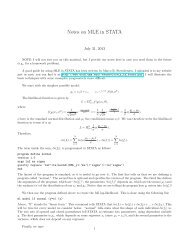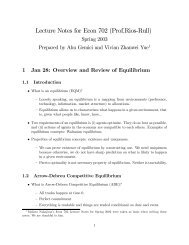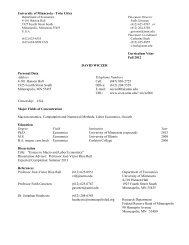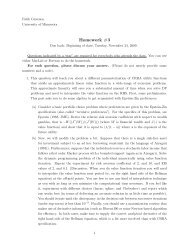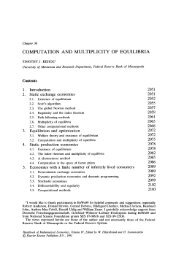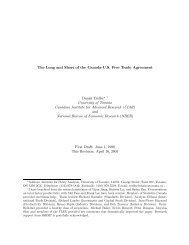Finite, countable and uncountable sets
Finite, countable and uncountable sets
Finite, countable and uncountable sets
You also want an ePaper? Increase the reach of your titles
YUMPU automatically turns print PDFs into web optimized ePapers that Google loves.
<strong>Finite</strong>, <strong>countable</strong> <strong>and</strong> un<strong>countable</strong> <strong>sets</strong><br />
Definition 1 (Injective function) Let f : S → T be a function. We say that f is injective if f(x) =f(y) ⇒<br />
x = y.<br />
Remark 2 f is injective iff x 6= y ⇒ f(x) 6= f(y).<br />
Definition 3 (Onto function) Let f : S → T be a function. We say that f is onto iff ∀y ∈ T ,thereexists<br />
some x ∈ S such that f(x) =y.<br />
Definition 4 (Bijection) Let f : S → T be a function. We say that<br />
onto.<br />
f is a bijection iff f is injective <strong>and</strong><br />
Definition 5 (Cardinality of a set) Let S be a finite set, S = {s 1 ,s 2 , ..., s n }. Then the cardinality of S is<br />
|S| = n.<br />
Proposition 6 Suppose that S <strong>and</strong> T are finite. Then |S| = |T | iff there exists a bijection f : S → T .<br />
Proof. "⇒"<br />
Suppose that |S| = |T | = n, S, T are finite <strong>sets</strong>. Then S should be of the type S = {s 1 ,s 2 , ..., s n } <strong>and</strong><br />
T = {t 1 ,t 2 , ..., t n }. Consider the function f : S → T , s i → t i . This function is a bijection.<br />
"⇐"<br />
Suppose that f : S → T is a bijection. We need to show that |S| = |T |. Suppose not. Then we have 2<br />
alternatives:<br />
(a) |S| > |T |, whereS = {s 1 ,s 2 , ..., s n ,s n+1 , ..., s m } <strong>and</strong> T = {t 1 ,t 2 , ..., t n }. Then f(s 1 ) 6= f(s 2 ) 6= ... 6=<br />
f(s n ),sincef is injective. But f(s n+1 )=t j = f(s i ) for some i ∈ {1, ..., n}, which is a contradiction with<br />
the injectivity of f.<br />
(b) |S| < |T |, whereS = {s 1 ,s 2 , ..., s m } <strong>and</strong> T = {t 1 ,t 2 ,...,t m ,t m+1 , ..., t n }. Then ∀i ∈ {1, ..., m},<br />
t i = f(s j ) (∀j ∈ {1, ..., m}), else the function is not onto. But then t m+1 6= f(s j ) for any j ∈ {1, ..., m}.<br />
Then f is not onto, which is a contradiction.<br />
Example 7 Consider a set A = {a 1 ,a 2 , ..., a n }.ThenthepowersetofA is defined as<br />
Then, |P(A)| =2 n .<br />
P(A) ={B|B is a subset of A} .<br />
Proof. Consider the set X = {0, 1} n , X = {(x 1 , ..., x n )|x i ∈ {0, 1}}. (A typical set has the form X =<br />
{0, 1, 1, 0,...,1}). Then |X| =2 n ½. Now we find a bijection between P(A) <strong>and</strong> X, f : P(A) → X, B →<br />
1 if ai ∈ B<br />
f(B) =(x 1 ,x 2 , ..., x n ) with x i =<br />
0 if a i /∈ B .<br />
(For example, consider A = {1, 2, 3, 4}. If B = {1, 2, 3} then f(B) = {1, 1, 1, 0}; if B = ∅, then<br />
f(B) ={0, 0, 0, 0}.)<br />
(a) f is injective.<br />
Consider B 1 ,B 2 ∈ P(A). Suppose that f(B 1 )=f(B 2 ). We need to show that B 1 = B 2 . Note that<br />
a i ∈ B 1 ⇔ [f(B 1 )] i =1⇔ [f(B 2 )] i =1(since f(B 1 )=f (B 2 )) ⇔ a i ∈ B 2 .ThenB 1 = B 2 .<br />
(b) f is onto.<br />
We need to show that ∀x ∈ X, there exists some B ∈ P(A) such that f(B) = x. Consider x =<br />
(x 1 ,x 2 , ..., x n ) ∈ X, <strong>and</strong>B = {a i |x i =1}. Thenf (B) =x.<br />
Since f is injective <strong>and</strong> onto, then f is bijective, <strong>and</strong> therefore |P(A)| = |X| =2 n .<br />
Definition 8 For infinite <strong>sets</strong>, we say that |A| = |B| iff there exists a bijection f : A → B.<br />
Definition 9 (Denumerable <strong>and</strong> <strong>countable</strong> <strong>sets</strong>) If |A| = |N| then we say that A is denumerable. If |A| = |N|<br />
or A is finite, then A is <strong>countable</strong>.<br />
Proposition 10 |N| = |Z|.<br />
1
½<br />
Proof. Define a function f : N → Z, n →<br />
n<br />
2<br />
if n is even<br />
−(n+1)<br />
2<br />
if n is odd .<br />
(a) f is injective.<br />
Suppose that f(n 1 )=f (n 2 ).<br />
(a.1) Let f(n 1 )=f(n 2 ) ≥ 0. Then n1<br />
2 = n2<br />
2 ⇒ n 1 = n 2 .<br />
(a.2) Let f(n 1 )=f(n 2 ) ≤ 0. Then −(n+1)<br />
2<br />
⇒ n 1 = n 2 .<br />
(b) f is onto.<br />
Consider any z ∈ Z.<br />
(b.1) Let z ≥ 0, <strong>and</strong> consider n =2z, whichisanevennaturalnumber.Thenf(n) = n 2 = (2z)<br />
2<br />
= z.<br />
(b.2) Let z < 0, <strong>and</strong> consider n = −(2z +1), an odd natural number. Then f(n) = −(n+1)<br />
2<br />
=<br />
−(−(2z+1)+1)<br />
2<br />
= z.<br />
Then |N| = |Z|.<br />
2<br />
= −(n+1)<br />
Theorem 11 Any subset of a <strong>countable</strong> set is also <strong>countable</strong>.<br />
Proof. Assigned for homework.<br />
Theorem 12 Let S 1 ,S 2 ,... be a <strong>countable</strong> family of <strong>countable</strong> <strong>sets</strong>. Then S i≥1 S i is <strong>countable</strong>.<br />
Proof. S m is <strong>countable</strong> for m ≥ 1. Then it can be put into a bijection with a (possibly proper) subset of N<br />
S m = {(m, 1), (m, 2), (m, 3), (m, 4)...}.<br />
Then:<br />
S 1 = (1, 1), (1, 2), (1, 3), ...<br />
S 2 = (2, 1), (2, 2), (2, 3), ...<br />
S 3 = (3, 1), (3, 2), (3, 3), ...<br />
.<br />
S m = (m, 1) (m, 2) (m, 3) ...<br />
.<br />
And (1, 1) canbeassignedto1, (2, 1) to 2, (1, 2) to 3, (3, 1) to 4, (2, 2) to 5, <strong>and</strong>soon,soallelements<br />
can be covered without repeating.<br />
Now consider f : {(m, n) |m, n ∈ N ∗ } → N ∗ , (m, n) → (m+n−1)(m+n−2)<br />
2<br />
+ n. Thenf is an injection, but<br />
not necessarily onto (since some S i ’s can be finite <strong>and</strong> some elements of some S i ’s can be dropped because<br />
of repetition). However, for = {(m, n) |m, n ∈ N ∗ } then f : {(m, n) |m, n ∈ N ∗ } → f[S] is onto. Then,<br />
there is a bijection between S i≥1 S i <strong>and</strong> f[S]. Since f[S] ⊆ N, thenf[S] is <strong>countable</strong>, because of Theorem<br />
11. Then S i≥1 S i is <strong>countable</strong>.<br />
Corollary 13 |Q| = |N|.<br />
Proof. Note that Q can be expressed as<br />
Q = [ Q∈Z\{0}<br />
½ p<br />
q |p ∈ Z ¾<br />
.<br />
n o<br />
Call the set p<br />
q |p ∈ Z = B Q , the set of rational numbers with denominator q. Note that |B Q | = |Z|.<br />
(f : B Q → Z, p q → p is a bijection). Then B Q is <strong>countable</strong>.<br />
But note that the union is made in Q ∈ Z\{0}, which is <strong>countable</strong>. So we have that Q is a <strong>countable</strong><br />
union of <strong>countable</strong> <strong>sets</strong>, so Q is <strong>countable</strong>. If a set is <strong>countable</strong>, it can be the case that either |Q| = |N| or<br />
that Q is finite. Since Q is not finite, then |Q| = |N|.<br />
Theorem 14 R is not <strong>countable</strong>.<br />
2
Proof. It is enough to show that [0, 1] is not <strong>countable</strong>. Suppose that [0, 1] is <strong>countable</strong>. Then its elements<br />
can be put in a sequence:<br />
x 1 = 0.x 11 x 12 x 13 ...<br />
x 2 = 0.x 21 x 22 x 23 ...<br />
x 3 = 0.x 31 x 32 x 33 ...<br />
x 4 = 0.x 41 x 42 x 43 ...<br />
.<br />
where x ij are the digits of the number. Now we construct a number ¯x such that it is not in the list.<br />
Consider ¯x =0.¯x 1¯x 2¯x 3 ... defined as:<br />
½ 5 if xii =4<br />
¯x i =<br />
4 otherwise .<br />
Then ¯x 6= x n ∀n ∈ N since ¯x n 6= x nn . Therefore, no bijection between N <strong>and</strong> [0, 1] can be established,<br />
<strong>and</strong> R is not <strong>countable</strong>.<br />
Theorem 15 Any family of disjoint nonempty open intervals in R is <strong>countable</strong>.<br />
Proof. Let {(a λ ,b λ )} λ∈Λ<br />
be a family of open <strong>sets</strong>. Then there exists x λ in (a λ ,b λ ) such that x λ ∈ Q.<br />
Consider f : Λ → Q, λ → x λ . We now claim that f is injective. To see that this is so, suppose that<br />
λ 1 6= λ 2 , <strong>and</strong> without loss of generality, suppose that b λ1
Consider ¯x ∈ {0, 1} N defined by ¯x =(¯x 1 , ¯x 2 , ...), ¯x i =<br />
¯x n 6= x nn . It follows that A is not <strong>countable</strong>.<br />
½ 1 if xii =0<br />
0 if x ii =1 .Then ¯x 6= x n ∀n ∈ N since<br />
Remark 19 There is a bijection between P ({a 1 , ..., a n }) <strong>and</strong> {0, 1} N .<br />
between P(N) <strong>and</strong> {0, 1} N .ThenP(N) is not <strong>countable</strong>.<br />
In addition, there is a bijection<br />
Theorem 20 If f : R → R is a nondecreasing function, then the set of points where f is discontinuous is<br />
at most <strong>countable</strong>.<br />
Proof. Consider the family {x λ } λ∈Λ<br />
, the set of points where f is discontinuous. We need to show that Λ is<br />
<strong>countable</strong>. Note that if x is discontinuous at x λ ,then<br />
lim f(x) 6= lim f(x)<br />
x→x − λ<br />
x→x + λ<br />
Since f is nondecreasing,<br />
lim f(x) < lim f(x)<br />
x→x − λ<br />
x→x + λ<br />
It is possible to find Q λ ∈ Q such that<br />
lim f(x) x λ2 or<br />
x λ1 x λ2 ⇒ Q λ1 >Q λ2 ⇒ g(λ 1 ) >g(λ 2 ). In the second case, x λ1



